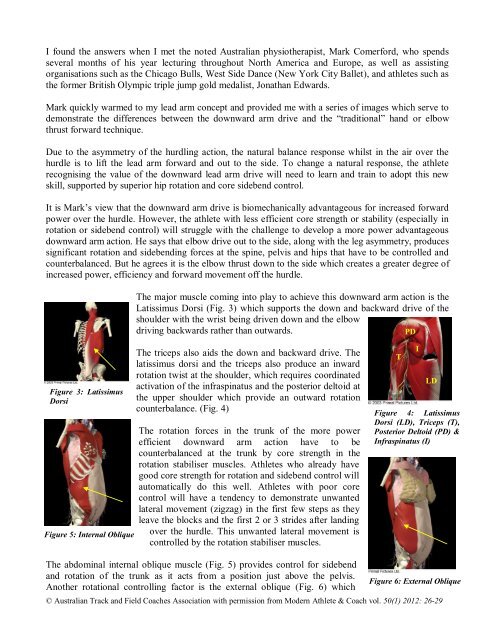Hurdle Performance: lead arm technique advancement - The ...
Hurdle Performance: lead arm technique advancement - The ...
Hurdle Performance: lead arm technique advancement - The ...
Create successful ePaper yourself
Turn your PDF publications into a flip-book with our unique Google optimized e-Paper software.
I found the answers when I met the noted Australian physiotherapist, Mark Comerford, who spends<br />
several months of his year lecturing throughout North America and Europe, as well as assisting<br />
organisations such as the Chicago Bulls, West Side Dance (New York City Ballet), and athletes such as<br />
the former British Olympic triple jump gold medalist, Jonathan Edwards.<br />
Mark quickly w<strong>arm</strong>ed to my <strong>lead</strong> <strong>arm</strong> concept and provided me with a series of images which serve to<br />
demonstrate the differences between the downward <strong>arm</strong> drive and the “traditional” hand or elbow<br />
thrust forward <strong>technique</strong>.<br />
Due to the asymmetry of the hurdling action, the natural balance response whilst in the air over the<br />
hurdle is to lift the <strong>lead</strong> <strong>arm</strong> forward and out to the side. To change a natural response, the athlete<br />
recognising the value of the downward <strong>lead</strong> <strong>arm</strong> drive will need to learn and train to adopt this new<br />
skill, supported by superior hip rotation and core sidebend control.<br />
It is Mark’s view that the downward <strong>arm</strong> drive is biomechanically advantageous for increased forward<br />
power over the hurdle. However, the athlete with less efficient core strength or stability (especially in<br />
rotation or sidebend control) will struggle with the challenge to develop a more power advantageous<br />
downward <strong>arm</strong> action. He says that elbow drive out to the side, along with the leg asymmetry, produces<br />
significant rotation and sidebending forces at the spine, pelvis and hips that have to be controlled and<br />
counterbalanced. But he agrees it is the elbow thrust down to the side which creates a greater degree of<br />
increased power, efficiency and forward movement off the hurdle.<br />
Figure 3: Latissimus<br />
Dorsi<br />
Figure 5: Internal Oblique<br />
<strong>The</strong> major muscle coming into play to achieve this downward <strong>arm</strong> action is the<br />
Latissimus Dorsi (Fig. 3) which supports the down and backward drive of the<br />
shoulder with the wrist being driven down and the elbow<br />
driving backwards rather than outwards.<br />
PD<br />
<strong>The</strong> triceps also aids the down and backward drive. <strong>The</strong><br />
latissimus dorsi and the triceps also produce an inward<br />
rotation twist at the shoulder, which requires coordinated<br />
activation of the infraspinatus and the posterior deltoid at<br />
the upper shoulder which provide an outward rotation<br />
counterbalance. (Fig. 4)<br />
<strong>The</strong> rotation forces in the trunk of the more power<br />
efficient downward <strong>arm</strong> action have to be<br />
counterbalanced at the trunk by core strength in the<br />
rotation stabiliser muscles. Athletes who already have<br />
good core strength for rotation and sidebend control will<br />
automatically do this well. Athletes with poor core<br />
control will have a tendency to demonstrate unwanted<br />
lateral movement (zigzag) in the first few steps as they<br />
leave the blocks and the first 2 or 3 strides after landing<br />
over the hurdle. This unwanted lateral movement is<br />
controlled by the rotation stabiliser muscles.<br />
<strong>The</strong> abdominal internal oblique muscle (Fig. 5) provides control for sidebend<br />
and rotation of the trunk as it acts from a position just above the pelvis.<br />
Another rotational controlling factor is the external oblique (Fig. 6) which<br />
Figure 4: Latissimus<br />
Dorsi (LD), Triceps (T),<br />
Posterior Deltoid (PD) &<br />
Infraspinatus (I)<br />
© Australian Track and Field Coaches Association with permission from Modern Athlete & Coach vol. 50(1) 2012: 26-29<br />
T<br />
I<br />
LD<br />
Figure 6: External Oblique


